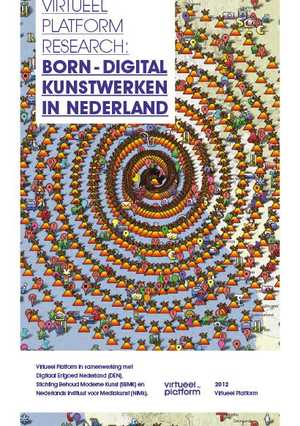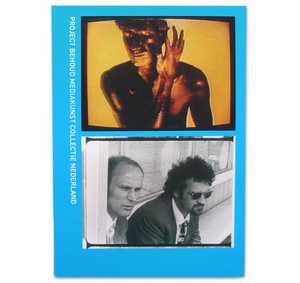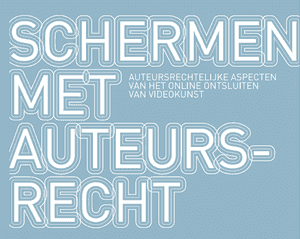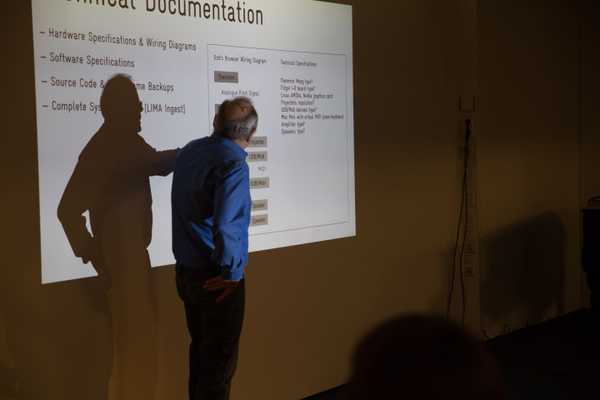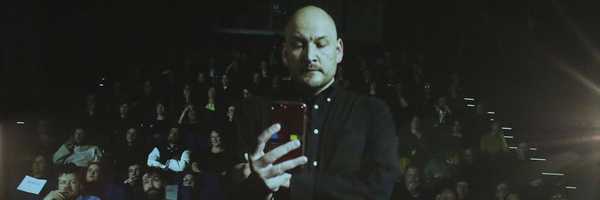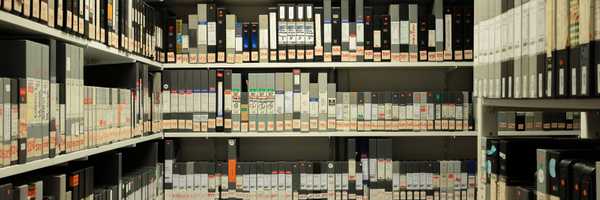
LI-MA's Preservation History
Learn about the history of preserving media art at LI-MA and in the Netherlands.
LI-MA’s legacy started in the 1970s when Rene Coelho founded MonteVideo, a media art gallery in Amsterdam this grassroot organisation became over time, together with Time Based Arts, the Netherlands Media Art Institute (NIMk). In December 1992, MonteVideo / TBA, Amsterdam, started the first phase of a national video preservation project. This project would lay the foundation for media art conservation in the Netherlands.
The Start of Media Art Preservation in the Netherlands
Worldwide promotion and presentation of media artworks since the late 1970s gave distributor MonteVideo a profound knowledge regarding the transmission of media artworks to continuously changing displays and locations. It aided them in the development of documentation and installation methodologies as well as the creation of an infrastructure to manage all these artworks, copies, and derivatives. Distribution also led to a proactive involvement in artistic practices, new methods, technologies and art forms. The resulting knowledge – technical, legal, promotional, and organizational – was coupled with a deep understanding of the material. Leading to a practice in which not just the importance of distribution was emphasized, but also the conservation of media artworks.
Preservation Phase 1 - Betacam SP (1993 - 1994)
Since 1965 artists and activists have used open-reel tape. This remained common until the 1980s when cassette formats, such as U-Matic and Betacam, surpassed them in popularity. It was also in the 1980s that institutions began to take an interest in adding video art to their collections, focusing on early works on tape and expanding to later include other culturally important works.
MonteVideo / TBA began to migrate video artworks and became the center of expertise for media art preservation in the Netherlands. Early migration projects included the transfer to Betacam SP of the media artworks that were threatened with erosion from 9 important collections. Central questions regarding this project were the status of the vehicle (‘not the tape (object) as the artwork but the artwork (information) on the tape’ ), the significance of the material, artistic concept, the method chosen, and how to establish the best conditions for future presentation.
Preservation Phase 2 - Digital Betacam (2001 - 2003)
In 1996, Gaby Wijers (LI-MA’s director) entered the field of media art preservation when she began her work at MonteVideo/TBA. Her first task was to research current preservation and digitisation techniques while coordinating the next phase for the Stichting Behoud Moderne Kunst (SBMK, Foundation for the Conservation of Contemporary Art). Around that time transfering vulnerable audiovisual material to Digital Betacam, in close cooperation with artists and guided by pertinent documentation, was seen as best practice. Authenticity and uniqueness of ‘the manifestation’, was a theme of debate.

Preservation Phase 3: LTO & Digital Art (2010–2012)
From 2009 onwards, NIMk, in collaboration with SBMK and 15 collections, conducted research into the next step regarding the preservation of media art, using LTO data tape as the next medium for conservation. Analogue works were digitised uncompressed in order to preserve their unique qualities, while the rise of born-digital artworks presented new questions regarding their continued sustainable access. This resulted in research, conferences and publications conducted together with Virtueel Platform (2007–2012), the sector institute for digital culture, into the status and pressing needs of born-digital artworks in the Netherlands. Besides this, research and publications regarding the copyright aspects of online accessibility for video art were also completed.
Besides the national projects linked below, NIMk participated in several other groundbreaking international preservation projects, including 404 Object not Found, Inside Installation, Inside Movement Knowledge, OAIS and Obsolete Equipment.
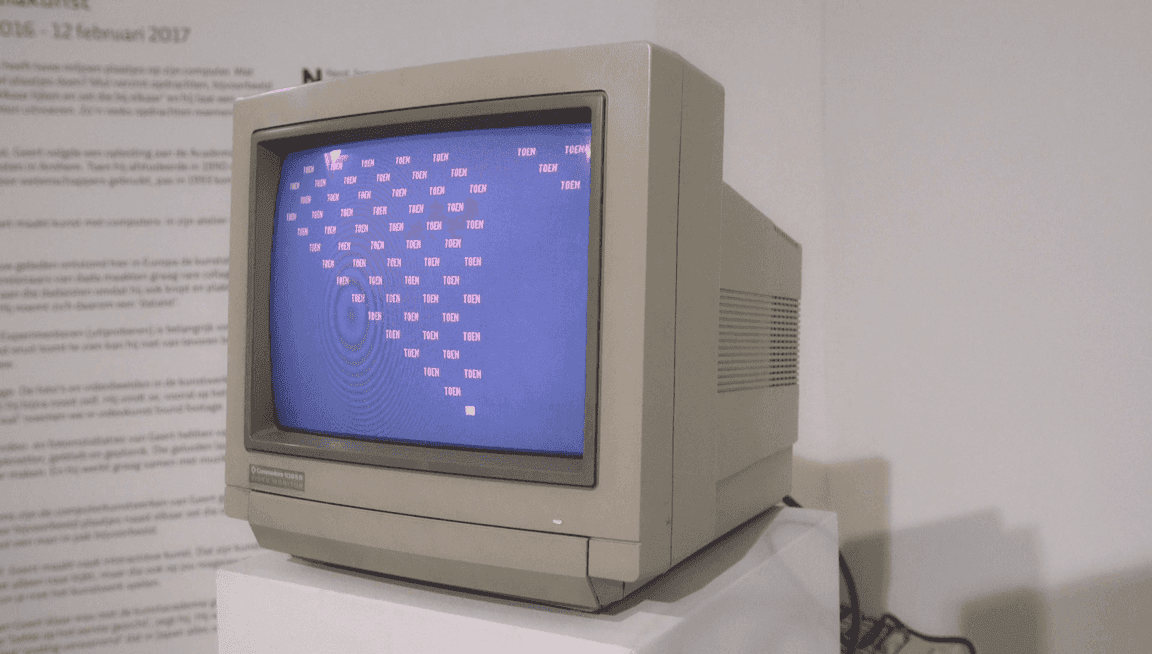
Registratie Schiedam. Productie LI-MA
Preservation Projects Since 2013
With the founding of LI-MA in 2013, a digital repository and services were put in place to support the preservation needs of artists and collections. In collaboration with SBMK, NDE and artists, a number of enduring preservation projects were initiated that focused on the preservation of VR, CD-ROMs, and digital and online art. These included, notably, Transformation Digital Art, Future Proof, UNFOLD, Arthost, and the Collaborative Infrastructure for Sustainable Access to Digital Art projects. The results of these projects have empowered artists and collections to take care of their media artworks and provided the tools and services for them to do so. In addition, they have explored the possibilities of documentation and reinterpretation as preservation strategies while also creating platforms for knowledge sharing through workshops, lectures and an annual international symposium Transformation Digital Art.
Conservation as Care and Management of Change
“What to preserve and how?” is still a fundamental question in media art conservation. In order to answer it, the social and technical context of the work must be understood – pinpointing what needs retaining and the actions needed to keep it accessible while preserving its intended meaning. Conservation is a lifelong process that depends on a collaborative network of experts and regular maintenance. Besides preservation and digitisation activities, conservation includes planning for updates, treatment, maintenance, management and storage with the aim of making a collection available for use and reuse. All active preservation actions are subject to the conservation code of ethics which requires reversibility, transparency and full documentation. This documentation forms the necessary framework for future presentation and is of utmost importance when determining which preservation strategy is best. Over the years, artistic practice based on technology, divergence and change has increased. With the development and emancipation of the art form and its practice, reflection and perception has changed. Changing with it is the media art conservation mindset, as ideas regarding the management of change, networks of care and distributed knowledge gain ground.
(This text is an edited excerpt from the article ''Taking Care of Media Art in the Netherlands: A Brief History'' by Gaby Wijers in A Critical History of Media Art in the Netherlands, ed. Sanneke Huisman and Marga van Mechelen. Jap Sam Books, 2019)
1. http://nimk.nl/eng/project-preservation-video-art


